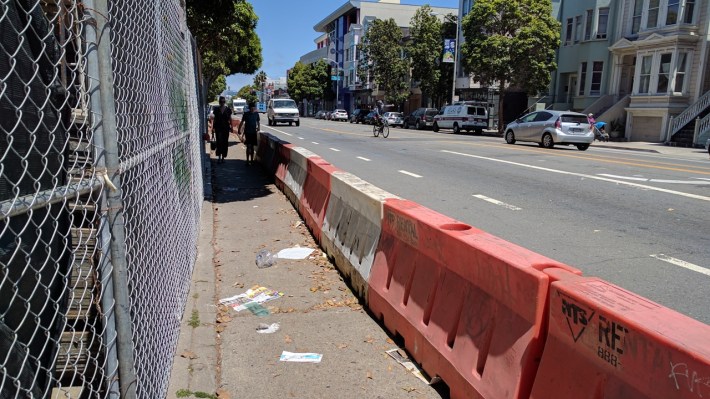On Tuesday, Streetsblog covered a talk about protected bike lanes. Ryan Russo, head of Oakland’s newly formed Department of Transportation, and Mike Sallaberry, Project Manager for SFMTA’s Livable Streets division, supported the panel's conclusion that protected bike lanes must become the new normal for street design.
But two days later, I went through MacArthur BART station and saw the barriers on 40th street, in front of the construction site for a transit village. As seen in the lead image, the barriers are on the right side of the bike lane, where they leave cyclists completely exposed to collisions with cars, trucks, and buses. In other words, not protected, in a situation where it would cost nothing to do it.
So why the disconnect with what senior managers say they want and what actually gets done on street level?
Oakland's Joe Wang, Supervising Transportation Engineer, is in charge of temporary traffic control plans. Streetsblog emailed Wang and called twice (his voicemail is full) with that question, and will update this post accordingly.
"My expectations are so low that I was thrilled to see them manage to just keep the pedestrian path and bikeway open on that part of 40th at all," said Robert Prinz, Education Director for Bike East Bay, in an email to Streetsblog. "There seems to be an attention/capacity issue for OakDOT to not only consistently implement similar or better facilities as part of other projects, but also to monitor them throughout the construction process to ensure that they remain open and safe to use."
"Is there always enough room for a cyclist to pass somebody in a wheel chair?" asked Jeff Tumlin, Principal and Director of Strategy at NelsonNygaard Consulting, who oversaw the creation of Oakland's Department of Transportation, speculating about why the barrier is on the right of the bike lane. "If not, you’ve just violated the Americans with Disabilities Act,"

Presumably Wang knows which explanation is correct, but as Streetsblog has covered previously, other countries seem to find ways to protect walkers and bikers, even during construction. European disability laws don't stop them.
"Keep in mind in Denmark [for example] protected bikeway is the rule, so it’s easy for a construction project to fold it into the dominant thinking without any risk because everyone is used to it," said Tumlin. "If we want to push innovation where are the best levers to push? Is it where there’s a temporary public right of way under construction? That's not a place that’s likely to push us towards success. It's much better to push on DOTs."
Tumlin may be right, but in the meantime, as Streetsblog watched, a cyclist almost got pinched between that barrier and an AC Transit bus that pulled right without signaling. It was only the cyclist's skills and a bit of luck that prevented another tragedy. It's just not a safe situation to have bikers wedged between motor traffic and a barrier or a row of parked cars.
To achieve the goals of Vision Zero, it's not going to be enough to fix big intersections and streets as part of high-profile, major projects. The small stuff matters too. The culture of Bay Area DOTs has to change until protecting vulnerable road users is peremptory--all the way down to how you place barriers at a block-long construction project.







